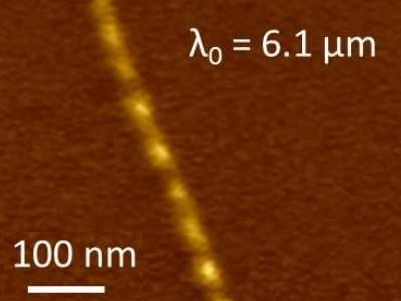Feng Wang and Zhiwen Shi, University of California at Berkeley, CA, USA, and colleagues have observed Luttinger-liquid plasmons in metallic single-walled nanotubes (SWNT) using scattering-type scanning near-field optical microscopy (s-SNOM). A Luttinger-liquid describes the flow of electrons through one-dimensional objects, such as a SWNT. Metallic SWNTs with diameters ranging from 1.2 to 1.7 nm were grown, purified, and then deposited on a boron nitride substrate. Single wavelength infrared light was focused onto the tip of an Atomic Force Microscope (AFM) to excite and detect a plasmon wave along an SWNT.
The team demonstrated that Luttinger-liquid plasmons of 1-D conduction electrons in SWNTs behave much differently from classical plasmons. They propagate at semi-quantized velocities that are independent of carrier concentration or excitation wavelength. They simultaneously exhibit extraordinary spatial confinement, a high quality factor, and low dispersion.
To be manipulated efficiently with a photonic device, the light wavelength has to be smaller than the device. By concentrating photon energy at deep sub-wavelength scales, Luttinger-liquid plasmons in SWNTs effectively reduce the light wavelength. The plasmon wavelength is only one hundredth of the free-space photon wavelength. This should allow for the miniaturization of photonic devices down to the nanometer scale.
The researchers think that their observations could hold great promise for novel plasmonic and nanophotonic devices over a broad frequency range, including telecom wavelengths.
- Observation of a Luttinger-liquid plasmon in metallic single-walled carbon nanotubes,
Zhiwen Shi, Xiaoping Hong, Hans A. Bechtel, Bo Zeng, Michael C. Martin, Kenji Watanabe, Takashi Taniguchi, Yuen-Ron Shen, Feng Wang,
Nature Photonics 2015.
DOI: 10.1038/nphoton.2015.123

